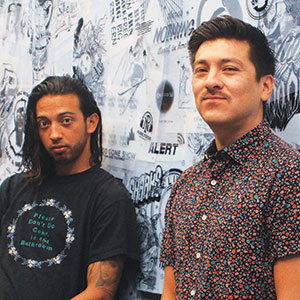
Please don’t do Coke In The Bathroom.” Downtown denizens will recognize the cross-stitch, originally embroidered by local artist and Local Color founder Erin Salazar and hung on the door of the Good Karma restroom.
Those less familiar with the long-running San Jose vegan restaurant may have first encountered the same design on a T-shirt. This garment is the work of Downtown Screen Printers.
Jimmy Fonseca and Aliks Hernandez, the pair of artists behind DTSP, have been accruing quite the portfolio. The collection of designs on their studio wall serves as a roadmap, chronicling two years of wearable work.
Each paper-thin plastic sheet serves as a waypoint on the DTSP journey. There’s the face of Mighty Mike McGee, “Homegirls Por Vida”mantra of local DJ Emzand the Clandestine Brewing logo, a graphic of a woman brewmaster.
Fonseca and Hernandez met at Local Color. Fonseca moved his creative energy into the collective studio when it first opened in 2016; Hernandez joined the space a little later, mainly to access the screen printing tools the collective had acquired. The two saw a potential for collaboration.
Fonseca had the color separation and graphic design expertise, while Hernandez knew the basics of screen printing. “We each had both ends of the spectrum covered separately, so working together just made it fit perfectly,” Hernande says.
Since 2018, the two artists have been deepening that screen printing craft, establishing a brand for themselves and working with a diversified client group. The jobs they run can range from tattoo shops, construction companies, schools and beyond. Sometimes they touch upon all of those categories in a single day.
They’re collaborating with people from all walks of industry and life, including other creatives.
Recently, the “San Jose” logo that Nicholas Jimenez designedone that became a regional Snapchat geofilter with 29.9 million views and 655,000 usesfound a new home on DTSP-produced black T-shirts.
“I really like taking artwork, preserving the integrity of the art, and transferring that into a screen print. I view it as an artist, not as a screen printer,” Fonseca says. Both he and Hernandez are artists first, screen printers second. They view the work they do as reproducing art with more art. Instead of using digital printers, these two are bringing designs and artwork to life the old-fashioned waywith their bare hands.
To create the stencil-like screen that’s used in screen printing, they first print a designentirely blackon a special film. Next, a silk screen is coated in emulsion and placed on a light table with the film design in place. The emulsion cures on exposure to the light, excluding whatever area is covered by the design. After a good wash and dry, the screen is ready for action.
Local Color’s massive garment press looks like something that might rove around the surface of Mars. Once the screen is prepared, it is secured onto the hulking apparatus. Using a squeegee, the artist moves ink across the screen. After baking in the 350-degree drying oven for just a few minutes, the shirt is ready to wear.
As of now, the merchandise they’ve printed is worn all over the South Bay. You might see an ostrich-riding Teresa ghost from Mario and Yoshidesigned for the relatively new Miniboss video game bar by painter and Dredg bassist Drew Roulettewalking down the street. Bill the Butcher might wait for you on someone’s chest at the end of a dark hallway; that one was originally created by artist Francisco Ramirez for Five Points craft cocktail bar.
Fonseca and Hernandez are getting accustomed to seeing their prints walking around town, not something all artists experience. “Before, at the beginning, I’d be like, ‘Hey, I like your shirt. I designed it, or I printed it,'” says Fonseca. “But now, it’s kind of like, alright, it’s normal, and I try not to geek out about it.”


